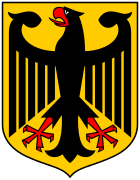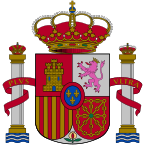Germany–Spain relations
show This article may be expanded with text translated from the corresponding article in German. (September 2017) Click [show] for important translation instructions. |
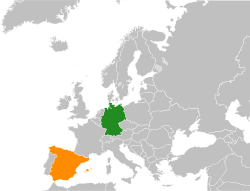 | |
Germany |
Spain |
|---|---|

Germany–Spain relations (German: Deutschland-Spanien-Beziehungen; Spanish: Relaciones Alemania-España) refers to the diplomatic relations between Germany and Spain. Both nations are members of the European Union, Organisation for Economic Co-operation and Development, NATO and the United Nations.
Country comparison[]
| show |
|---|
History[]
Antiquity[]

In ancient times, both Hispania and the western and southern parts of present-day Germany were under Roman rule. After the Migration Period of the late antiquity, German tribes also dominated areas on the Iberian Peninsula, creating the Kingdom of the Suevi (from 409) and the Visigothic kingdom (beginning with the second half of the 5th century). From 711, much of Spain came under Muslim Rule. Only Karl Martell, king of the Frankish Empire, which at that time included French and German territories, was able to stop the Moorish advance from Spain into south-west France with the Battle of Tours. Only in the north of the Iberian peninsula were Christian rulers able to assert themselves. From there, in 722, began the Spanish Reconquista.
Alfons X.[]
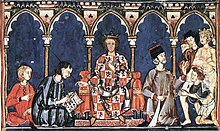
Also Alfonso X., King of León and Castile from 1252 to 1282, led a crusade against the Moors.
This ruler was from 1257 to 1273 also King Counter-king of Holy Roman Empire, which was related to his mother: His descent from the German family of Hohenstaufen through his mother Elisabeth, a daughter of the king Philipp von Schwaben, gave him the right to represent the Swabian line. The election of Elector in 1257, after the death of William of Holland in 1256, in which he received the same number of votes (both three votes) as the opponent Richard of Cornwall, seduced him to aim for the prestigious Kaiser crown through the Roman-German kingship; However, this was never realized, because he could not raise the necessary money for a Romzug. In order to get money, he worsened the coins and then tried to control the price increase by an idiosyncratic tax system. The retail trade in its territory was ruined, and the citizens and peasants were badly damaged. The unanimous election Rudolf I of Habsburg to the Roman-German King in 1273 actually meant Alfons' deposition as king of the Holy Roman Empire.
Karl V: "In my kingdom the sun never sets"[]

'Burgundy:' Castile
'Red:' 'Aragon's possessions
'Orange:' Burgundian possessions
'Yellow:' Austrian hereditary land
'Pale yellow:' Holy Roman Empire
The Reconquista was completed by the Catholic Kings Queen Isabella I of Castile and King Ferdinand II. Of Aragón in 1492. In the same year, the sailor Christopher Columbus discovered America and laid the foundation stone for the Spanish Empire. The heir of Isabella, who died in 1504, was her son John, Prince of Asturias. He married Margaret of Burgundy in 1496, the daughter of the later German Maximilian I, Holy Roman Emperor, but died in 1497 without heirs. His younger sister Joanna married in 1497 the Habsburg Philip I of Castile (1478-1506), who was also a son of Maximilian I, Holy Roman Emperor, also Duke of Burgundy. However, after showing signs of "madness" in the eyes of her contemporaries, Ferdinand took over. With the death of Ferdinand, the eldest son of Joanna's marriage Charles fell to the Spanish heritage.

To secure the heritage, Charles concluded the Treaty of Noyon in 1516 for understanding with France.[9] In 1519, after his grandfather Maximilian had died, he was also struck by the Austrian - habsburg inheritance. He was elected Roman-German King and assumed the title "Chosen Emperor" at his coronation in 1520. Francis I of France and Henry VIII of England also applied for Maximilian's succession, and finally , and Karl's brother Ferdinand was at times as a candidate in the conversation. The decisive factor was the financial support provided by the Fugger. The total cost of the election was 851,918 guilders, of which the Fuggers alone raised 543,585.[10] In Spain, the broke out against the reign of Karl, a foreigner, who had raised taxes to finance his wars. The insurrection was mainly supported by the bourgeoisie of the cities of Castile, in particular [Toledo]. He found support in parts of the clergy and the nobility. His goal was to limit the royal power in favor of Cortes. In the Kingdom of Valencia he came to a social revolutionary movement, the Germania. The rebels under were defeated at Villalar in 1521, the rebellion finally suppressed in 1522. After securing power, Spain became a central power base of the emperor.
Wars with France and the Ottomans (1521-1556)[]
At European level, the fighting between France and the Habsburgs was of great importance. For the Emperor it was dangerous, as the Pope and Venice tended increasingly to the side of France. In 1525 Charles' troops captured Francis I in the Battle of Pavia (1525).[11] But Karl joined the proposals for a moderate peace.[12] This led to the signing of the in 1526, in which France relinquished its claims in northern Italy, Karl hoped to be able to persuade Franz to fight together against the Ottomans and against the Lutherans.[13] But after Franz was released, he revoked the contract. He managed to win with the Holy League of Cognac from the Pope, Venice, Florence and finally even Milan allies.
Division of the Habsburg Empire, Philip II (1556-1598)[]

When Charles V put down the government in 1556, Spain lost the Austrian possessions of the House of Habsburg and the imperial crown, but retained the Netherlands, the Franche-Comté, the Duchy of Milan, and the kingdoms. Naples, Sicily and Sardinia. In 1570 his son and successor, Philip II, married Anna of Austria (1549-1580), the mother of the heir apparent Philip.
In the 16th century, the Ottoman Empire was an expansive major power. Venice and Spain sent a common fleet into the eastern Mediterranean, which defeated the Turks in the Battle of Lepanto on 7 October 1571. Although Holy Roman Empire of the German Nation was not part of the Holy League, its Commander-in-Chief Juan de Austria, an extra-marital son of Emperor Charles V. and the bourgeois Regensburg he Gürtler s daughter Barbara Blomberg.
Spanish Succession War (1701-1714)[]
The extinction of the Spanish Habsburgs in 1701 triggered the Spanish Succession War. The around the Austrian - Habsburg Emperor, the Holy Roman Empire, England and Great Britain and the Netherlands fought against and its allies Kurköln, and the Electorate of Bavaria.[14] The war took an unfavorable turn for Habsburg with the death of , but it also shook the forces of France. The Austrian house Habsburg had become under Leopold I. and Joseph I. nevertheless to the European great power. In the end, France succeeded in establishing as king of Spain. Thus the dynasty of the , which reigns today, was founded in Spain. Almost all the powers involved in the war had achieved at least partial successes at the end of the war.
19th century[]
Leopold von Hohenzollern: Spanish succession disputes lead to the Franco-Prussian War. In 1869, the Spanish Cortes proclaimed a new constitution that envisaged a parliamentary monarchy as a form of government. A promising royal candidate was Prince Leopold of Hohenzollern-Sigmaringen, scion of a Catholic branch line of Hohenzollern. He was persuaded in the spring of 1870 by Otto von Bismarck to accept the candidature. Soon Leopold resigned from his candidacy, as France threatened war. The French objection to Leopold or the French demand "that S. Maj. The [Prussian] king committed himself for all future, never to give his consent again, if the Hohenzollern should come back to their candidature" - as that of Otto edited by Bismarck and thus deliberately pointed Emser Depesche, led to the German-French War. The victory of Prussia and its allies resulted in 1871 in the German Unification.
Reich Chancellor Bismarck described the German Reich as "saturated" in order to be able to insert the new power factor in Europe's center into the Concert of the Powers but Kaiser Wilhelm II, German Emperor from 1888 to 1918, demanded "a place in the sun" for the Germans. This world power policy brought Germany came into conflict with Spain in the Asian Pacific region over its plans to colonize some Micronesian islands claimed by Spain, even though it was a declining power and had already lost most of its American colonies in the Spanish American wars of independence. With Spain's loss in the Spanish American War they ceded their last American colonies (Cuba and Puerto Rico) to the United States along with the Asian colonies of the Philippines and Guam island. In 1898 the Spanish Empire tried to recover from the war by selling its remaining Pacific island colonies to the German Empire, ending with the by which Spain relinquished the Carolines, the northern Mariana Islands and Palau to Germany. These South Pacific areas became part of German New Guinea.
20th century[]
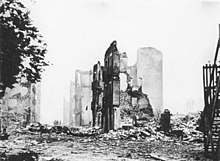
In World War I (1914-1918), Spain remained neutral, while Germany and the other Central Powers lost the war against the Triple Entente. This led to the abdication of all German monarchs. A side effect of the German defeat was that Germany failed as a rival of Spain in the struggle for colonial possessions in Morocco. The brothers Mannesmann had possession in the Moroccan Rif area, which corresponded to about one-eighth of the territory. In the the Spaniards tried to extend their rule to the entire colonial territory in northern Morocco. It was at the initiative of the king who wanted to exterminate the Rif Kabyles, Dirk Sasse: French, British and Germans in the Rifkrieg 1921–1926. Speculators and sympathizers, deserters and gamblers in the service Abdelkrims.[15][16] It was not until July 1927 that they had subjugated the entire area. The inter-war period was associated with great uncertainty and instability for most European countries. Democratic ideas were threatened on the right by fascist and on the left by communist ideologies. While in the Versailles Treaty hard-hit Germany, the Weimar Republic fought for its consolidation, it came in Spain to dictatorship under General Miguel Primo de Rivera (1923-1930) and 1931 to proclaim the Second Spanish Republic.
After the July 1936 semi-failed coup d'état in Spain that led to the start of the 1936–39 Civil War, Nazi Germany (along Fascist Italy) sided with the rebels and supplied them with money, munitions and manpower, including the intervention of the Condor Legion.
Germans on the Republican side[]
International Brigades, including Germans, fought against Franco's forces. The and the or the "Hans-Bataillon", the
came from Germany Group around comrades Hoffmann [17] the (group around ) and the , formed by Hans Beimler, unit in the Maxim Gorki Battalion, PSUC - Division Carlos Marx (later Thälmann Battalion).[18]
Members of the international POUM militia also fought for members of Trotskyist, and opposition communist groups such as the German SAP and KPO. Famous personalities like George Orwell and the later Social Democrat Member of Parliament Peter Blachstein fought in the POUM militia units. In the Málaga–Almería road massacre on the fleeing population of the city in February 1937 about 10,000 people were murdered. In the concentration camps, medical experiments were also carried out on the prisoners with National Socialist support.[19]
In February 1939 there were nearly 500,000 civil war refugees. They were initially interned mostly in the south of France. More than half returned to Spain in the next few months. In France remained about 150,000, many of them were sent as prisoners of war in different main camp and since August 6, 1940 in the Mauthausen concentration camp. More than 7,000 Spanish prisoners lived there, 5,000 of whom died. Some Spaniards were extradited to Franco by the Gestapo, others, such as the former head of government Francisco Largo Caballero, were deported to various German concentration camps. When the last Republican forces had given up, Franco proclaimed victory on April 1, 1939, the [Francoist Francoist] dictatorship prevailed throughout Spain.
Non-belligerent during World War II[]

Although Franco unquestionably had sympathy for the fascist regime in Italy and for the National Socialist regime in Germany, in practice the solidarity with his alleged ideological allies was limited. He was more likely to associate business relations with these regimes than an ideological community of fate. Spain joined the Anti-Comintern Pact in March 1939. Franco declared in July 1940 that his country was not neutral but merely a war leader.
In a letter dated 6 February 1941, Hitler told Franco "that we three men, the Duce, you and me, are bound together by the hardest compulsion of history that is possible, and that thus we in this historical analysis ought to obey as the supreme commandment the realization that in such difficult times, not so much an apparently wise caution as the bold heart, rather, can save nations."[20][21]
Characteristic of Franco 's attitude to the Axis n, however, is his behavior in Hendaye in 1940 (thus at the height of Nazi power in Europe) on the occasion of his only meeting with Hitler, when Franco not only demanded French colonial territory for Spain's entry into the war, but also refused to allow German troops into his country to let. According to his own statements, Franco is said to have even told Hitler that Spain will fight every invader to the last man, wherever he comes from. In addition, Franco demanded the supply of raw materials such as cotton and rubber, which Germany could hardly deliver. Franco, in spite of his superficial approval, finally closed Hitler's suggestion to occupy Gibraltar, which had long been demanded by England, because that would have meant Franco's entry into the Second World War.[22] His condolences finally consisted in sending the 'División Azul' 'to the Eastern Front, 47,000 Falangist volunteers under General Agustín Muñoz Grandes, but which he withdrew in 1943 after the Battle of Stalingrad there again. In addition, Franco Germany provided, inter alia, submarine bases and news material.
Adolf Hitler was dissatisfied with Franco's policy and in July 1942, in a small circle, began to consider "finding a suitable personality for the settlement of the Spanish political situation." He particularly thought of General Muñoz Grandes and said that the Blue Division might "play a crucial role in the settlement of the current Pfaff system."[23] In December 1943, Franco issued his position to the German ambassador saying that "the attitude of the Spanish government towards Bolshevism and Communism would not change, and that this struggle would continue at home and abroad, as well as against Judaism and Freemasonry "[24] More about the repression of Jews in the early Franco period see Bernd Rother:[25] Of these Sephards, some had descendants of 1492 displaced Jews in the 1920s who can accept Spanish citizenship. Franco's involvement was limited to those Sephards, which were relatively small with 4,500 of 175,000 sephards. At the latest since 1944, Franco had been informed in detail about the extermination of the Jews in KZ Auschwitz and it turns out that he knew the exact extent of the annihilation.[26]
The American historian Stanley G. Payne already sees withdrawal movements of Spain from Germany and Italy, even before the turn in Russia, as already at this time an article of a Falangist leader, in which Spain was differentiated from the totalitarian regimes, was allowed to print. In 1943, this idea became common knowledge, so that by the time the Second World War came to a close, Spain was well advanced on the path of transition from a partially mobilized, semi-fascist state to a Catholic, corporate and increasingly demobilized authoritarian regime.[27]"When Franco's defeat loomed around 1943, Franco withdrew from the Axis powers. He declared Spain neutral this year and, in exchange for allied oil supplies, largely cushioned Germany's material and non-material support. He also dismissed the sympathetic members of his government, including his brother-in-law Ramón Serrano Súñer. This shift allowed Franco to appease the Allies. In addition, during the Second World War, the abolition of external symbols such as the Fascist salute came. For Franco, Hitler and Mussolini were only interesting as long as they were powerful and he had something to expect from them. Another aspect, however, is that Spain, still severely weakened by the recent civil war, could not afford to participate in another gun campaign.
After the war, Spain was stationed on one of the so-called rat lines, the escape routes of the dignitaries of both the Nazi regime itself and its ideological allies - often for the purpose of traveling to South America. Some of them also found refuge in Spain itself, such as Léon Degrelle, leader of the Belgian Rexists.
Postwar[]
After the Second World War, the occupied and divided Germany initially fell out as a player on the international stage. After the victory of the Western democracies, the Spanish dictatorship was naturally isolated, which should, however, be defused by the looming Cold War for Franco.
In 1955, Spain was admitted to the United Nations. In 1973, the German Democratic Republic followed as the 133rd and the Federal Republic of Germany as the 134th member. From the beginning of the 1960s, Franco sought an [association] agreement with the EC. He submitted an application on February 9, 1962. It was only in 1966 that negotiations began, which were delayed until the conclusion of a first agreement in 1970, mainly due to political reservations of the then six states (including the FRG).
After the end of the Spanish dictatorship[]

The Spanish isolation could only be completely broken after Franco's death in 1975 and the subsequent democratization under King Juan Carlos I.
Spain joined the NATO in 1982; The Federal Republic of Germany belonged to the Atlantic Pact since 1955. In 1986 Spain became a member of the European Community and in 1988 the Western European Union. Spain also decided to use the Euro as the currency together with Germany and other European partners (1999 as book money, cash introduction 2002), so that no currency exchange between the two countries is necessary.
21st Century[]
In Iraq war in 2003, Spain joined the US despite the popular opposition of the "[Coalition of the Willing One]". Germany, together with Russia and France, refused to participate in the war on Saddam Hussein s. Foreign policy, however, Spain then approached again to Germany and France. Prime Minister Zapatero withdrew the troops from Iraq by July 2004, but he soon added to the military contingent in Afghanistan in view of the relations with the US damaged by the withdrawal until November 2013 34 Spaniards died.[28]
Current status[]
The relations between the German Government and the Government of Spain are unencumbered. At the end of March 2018, Catalan politician Carles Puigdemont was arrested in Germany. The possibility of extradition is currently being examined.[29]
Resident diplomatic missions[]
- Germany has an embassy in Madrid, a consulates-general in Barcelona and consulates in Las Palmas, Málaga and in Palma de Mallorca.[30]
- Spain has an embassy in Berlin and consulates-general in Düsseldorf, Frankfurt, Hamburg, Hannover, Munich and Stuttgart.[31]

Embassy of Germany in Madrid

Consulate-General of Germany in Barcelona

Embassy of Spain in Berlin

Consulate-General of Spain in Düsseldorf

Consulate-General of Spain in Hamburg
German community of Spain[]
See German Spaniards.
Related groups: Austrian Spaniards.
References[]
- ^ "Cifras de Población a 1 de julio de 2016. Estadística de migraciones. Primer semestre de 2016. Datos Provisionales" (in Spanish). Instituto Nacional de Estadística (INE). 16 December 2016.
- ^ Numbers and Facts about Church Life in Germany 2016 Report. Evangelical Church of Germany. Retrieved 14 June 2017.
- ^ Centro de Investigaciones Sociológicas (Centre for Sociological Research) (October 2017). "Barómetro de septiembre de 2017" (PDF) (in Spanish). Retrieved 27 December 2017.
- ^ "Padrón de Españoles Residentes en el Extranjero (PERE)" (PDF). Retrieved 5 December 2015.
- ^ For 2013 and 2014
- ^ https://web.archive.org/web/20180105221633/http://statisticstimes.com/economy/countries-by-projected-gdp.php
- ^ "World Economic Outlook Database, April 2017, Germany". International Monetary Fund. April 2017. Retrieved 1 October 2017.
- ^ "Spain". International Monetary Fund. Retrieved 8 May 2017.
- ^ Alfred Kohler: Charles V (1519-1556). In: The emperors of modern times. Munich 1990, p. 35.
- ^ Michael North: "The money and its history. From the Middle Ages to the present day. Beck, Munich 1994, p. 86.
- ^ Horst Rabe: Reich und Glaubens- schaltung. Germany 1500-1600. Munich 1989, p. 152.
- ^ Alfred Kohler: Charles V, Emperor. In: Neue Deutsche Biographie. 11 (1977), p. 196; online.
- ^ Horst Rabe: Reich und Glaubens- schaltung. Germany 1500-1600. Munich 1989, p. 153.
- ^ The Duchy of Savoy was part of the Bourbon Alliance until November 8, 1703, but then switched sides and joined the and thus the Habsburgs.
- ^ Dissertation. Münster 2003, p. 58f. in the course of October 1921 poison gas from the German Munsterlager- Breloh used.
- ^ Rudibert Kunz , Rolf-Dieter Müller: poison gas against Abd el Crimea. Germany, Spain and the Gas War in Spanish Morocco 1922-1927. Rombach, Freiburg 1990, p. 72.
- ^ Hanns Maaßen: Brigada Internacional is our honor name ... , Röderberg publishing house GmbH, Frankfurt / Main 1976, ISBN 3-87682-515-6, page 389
- ^ Sebastián Herreros Agüí: The International Brigades in the Spanish was 1936-1939: Flags and Symbols, Wall and Schützenzeitung of October 15, 1936(English; PDF, 6.4 MB), retrieved on September 3, 2012
- ^ Javier Bandrés, Rafael Llavona: La psicología en los campos de concentración de Franco. In: Psicothema. 8, 1 (1996), pp. 1-11. See Rafael Llavona and Javier Bandrés: Psicología y anarquismo en la guerra civil española: La obra de Félix Martí-Ibáñez. In: Psicothema. 10,3 (1998), pp. 669-678. ([online, PDF])
- ^ Hitler, Adolph; Franco, Francisco. "The Spanish Government and the Axis : Documents". avalon.law.yale.edu. Retrieved 2020-11-16.
- ^ Bernd Rill, in: Geschichte 2/2001, p. 36.
- ^ Compare yale.edu at the Wayback Machine (archived 2016-08-20) and yale.edu at the Wayback Machine (archived 2016-08-20)
- ^ Henry Picker: Hitler's Table Talks at Führer Headquarters 1941-1942 Seewald Verlag, Stuttgart 1976 ISBN 978-3-512-00425-4, p. 427f.
- ^ The Spanish Government and the Axis at the Wayback Machine (archived 2016-08-20)In 1938, the Synagogue of Madrid had been closed, the communities built in several cities during the war were dissolved again. The Difficult Return to Sepharad. at the Wayback Machine (archived 2008-03-28)In: Jewish Newspaper. March 2007. Only after 1945 were they allowed again.
- ^ j-zeit.de The difficult return to Sepharad. at the Wayback Machine (archived March 28, 2008) In: Jewish newspaper. March 2007. On the other hand, the [racial doctrine] represented by National Socialism found little echo in Spain. Roughly 20 to 35,000 European Jews were able to save themselves from the persecution via Spain. Spain and the Holocaust. Niemeyer Verlag, Tübingen 2001. Franco is said to be in favor of some of the Sephardic communities in Walther L. Bernecker: Spain's History since the Civil War. Beck, Munich 1997, p. 82.
- ^ 'Excelencia, esto ocurre en Auschwitz.' ' In:' 'El País.' 'March 21, 2010.
- ^ Stanley Payne: History of fascism. Rise and Fall of a European Movement . Tosa publishing house in the publishing house Carl Ueberreuter, Vienna 2006, ISBN 3-85003-037-7. P. 325
- ^ hndQry = Spain Operation Enduring Freedom, Coalition Deaths by Nationality at the Wayback Machine (archived June 29, 2015) Germany and Spain jointly participated in the Security and Reconstruction Mission under [NATO] International Security Assistance Force (ISAF).
- ^ FAZ: Federal government defends action of Spain.
- ^ Embassy of Germany in Madrid
- ^ Embassy of Spain in Berlin
- ^ As of July 2017 (www.worldometers.info/world-population/spain-population), Spain's population was 46,468,102. In the same month the number of citizens with Spanish citizenship reached 41,996,253. The number of foreigners (i.e. immigrants, ex-pats and refugees) permanently living in Spain was estimated to be at 4,426,811 (9.54%) in 2015.[1]
- Germany–Spain relations
- Bilateral relations of Germany
- Bilateral relations of Spain

